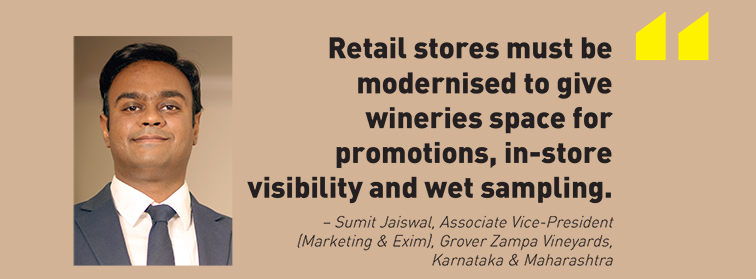One of the most important developments in today’s wine market is a shift in the consumer base, in both geographic and demographic terms. Exposure to new cultures, growth in foreign tourists, travel and overseas education are contributing to wine awareness, thereby leading to wine consumption in India.
In non-traditional wine-drinking countries, Millennials are drinking more wine than any of the previous generations did at their age. In traditional wine-drinking countries, they are drinking less, but better quality wine.
People are talking about wine more than ever – and I hope they never stop! They’re slowly getting to a point where they’re no longer intimidated by sommeliers. They’re reading stuff on the Web and even enrolling in wine education courses.
All this is seconded by the growth rate, a growing number of wine festivals and visitors to them, more number training and tasting sessions – and we also see substantial growth in the number of visitors at both our vineyard and winery in Nashik (Maharashtra) and in Nandi Hills (outside Bengaluru).
A lot of 5-star hotels also run wine programmes and many of them include Indian wines. Keeping in mind the price difference between Indian and imported wines, there is certainly a need to push more Indian wines, which is a beneficial business proposal for hotels as well.
Especially the wine-producing countries, most restaurants and hotels promote wine from their own region, forget about the country!
Quantum leap
Indian wines have taken a quantum leap in quality, yet are more economical than most imported wines, even after the duty-free adjustment. The disparity exists in the minds of Indian consumers, who think that imported wines are better.
But this is already changing across the board. Consumers are getting to taste domestic wines at many wine festivals and agree that Indian wines offer more bang for the buck.
First-hand experience of how wine is made, right from grapes to bottle, has always been a great way to make long-term loyal customers across the wine regions of the world. The same is true in India as well, where some wineries have the requisite tourism infrastructure.
It offers a great learning experience to consumers, who start buying wine from the winery directly as well.
Wines in cans are important in that such packaging takes away the complexity that has been associated with wines. It will help broaden the demographic outreach by lowering the age group of drinkers, presenting them with affordable wine, and increasing the number of occasions and shares.
Off-trade upgrade
We have not yet launched wines in cans; but we have launched a mulled wine, which has been very relevant in Covid-19 times. The start has been great!
However, most retail stores across the country must be modernised, which can give wineries space for promotions or in-store visibility options. Retailers can invest in better and informative shelving options, so that wines can be stored properly and eventually lead to higher sales.
Wet sampling in modern trade outlets can be promoted if wine license costs are reduced. Loyalty programmes can be started in collaboration with retail shops, where repeat customers can be rewarded by respective wine companies.
Yes, we do need the support of governments in a big way. State governments must reduce duties, reduce one-day license cost (in Maharashtra) and also drastically reduce license and registration costs. State governments must treat wine as an agronomical product, like it is done in most wine-producing countries of the world.














